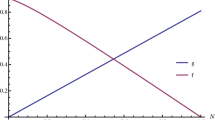Abstract
A prey–predator discrete-time model with a Holling type I functional response is investigated by incorporating a prey refuge. It is shown that a refuge does not always stabilize prey–predator interactions. A prey refuge in some cases produces even more chaotic, random-like dynamics than without a refuge and prey population outbreaks appear. Stability analysis was performed in order to investigate the local stability of fixed points as well as the several local bifurcations they undergo. Numerical simulations such as parametric basins of attraction, bifurcation diagrams, phase plots and largest Lyapunov exponent diagrams are executed in order to illustrate the complex dynamical behavior of the system.











Similar content being viewed by others
Notes
The shape of the Holling type I functional response is linear. So if the predators are spiders and the preys are biting flies, the number of flies killed by one spider is proportional to the flies’ density [4].
The results of the stability analysis have been exhibited by using the software package Maxima 5.27.0 (http://maxima.sourceforge.net/).
All numerical simulations were executed using the software package E&F Chaos [21].
This low-resting metabolic rate may be due to the fact that they use hydrostatic pressure for extending their appendages [26].
In addition, spiders can further reduce their metabolic rate below their already low levels when they experience periods of food limitation [27].
Many spiders, including both web-building and wandering spiders, are sit-and-wait predators that spend very little time in active locomotion [28]. For example, for the wolf spider Pardosa amentata, the daily energy loss attributed to locomotion was estimated to be only 1% of the daily energy usage of spiders [29].
The energetic costs of web production are relatively small because web building is often a short process and some spiders are able to recycle web proteins, which can substantially reduce the metabolic cost of silk production [29].
For example for the wolf spider Pardosa lugubris, the females invest 26% in reproduction and males invest only 16% [30].
Positive Lyapunov exponents correspond to diverging neighboring orbits, negative Lyapunov exponents correspond to converging orbits and zero Lyapunov exponents correspond to bifurcations that occur in the system [34].
References
Verhulst, P.F.: Notice sur la loi que la population suit dans son accroissement. Corresp. Math. et Phys. 10, 113–121 (1838)
Lotka, A.J.: Elements of Physical Biology. Williams and Wilkins, Baltimore MD (1925)
Volterra, V.: Fluctuations in the abundance of a species considered mathematically. Nature 118(2972), 558–560 (1926)
Holling, C.S.: The components of predation as revealed by a study of small-mammal predation of the European pine sawfly. Can. Entomol. 91(5), 293–320 (1959)
Holling, C.S.: The functional response of predators to prey density and its role in mimicry and population regulation. Mem. Entomol. Soc. Can. 45, 1–60 (1965)
Rosenzweig, M.L., MacArthur, R.H.: Graphical representation and stability conditions of predator–prey interactions. Am. Nat. 97(895), 209–223 (1963)
Maynard, S.J.: Mathematical Ideas in Biology. Cambridge University Press, Cambridge (1968)
Hadeler, K.P., Gerstmann, I.: The discrete Rosenzweig model. Math. Biosci. 98(1), 49–72 (1990)
Danca, M., Codreanu, S., Bako, B.: Detailed analysis of a nonlinear prey–predator model. J. Biol. Phys. 23(1), 11–20 (1997)
Liu, X., Xiao, D.: Complex dynamic behaviors of a discrete-time predator–prey system. Chaos, Solitons Fractals 32(1), 80–94 (2007)
Maynard, S.J.: Models in Ecology. Cambridge University Press, London (1974)
Hassel, M.P.: The Dynamics of Arthropod Predator–Prey Systems. Princeton University Press, Princeton (1978)
Taylor, R.J.: Predation. Chapman & Hall, New York (1984)
Pollock, S.T.: Ecology, vol. 10. Dorling Kindersley, London, Eyewitness Science (1993)
Last, J.M.: A Dictionary of Epidemiology. Oxford University Press (2000)
Ryan, K.J., Ray, C.G.: Sherris Medical Microbiology: An Introduction to Infectious Diseases, 4th edn. McGraw-Hill Medical (2003)
Mandell, G.L., Bennett, J.E., Dolin, R.: Mandell, Douglas, and Bennett’s Principles and Practice of Infectious Diseases, 7th edn. Churchill Livingstone (2009)
Oldstone, M.B.A.: Viruses, Plagues, & History, 1st edn. Oxford University Press, USA (1998)
Lehrer, S.: Anopheles mosquito transmission of brain tumor. Med. Hypotheses 74(1), 167–168 (2010)
Jury, E.I.: Inners and Stability of Dynamic Systems. Wiley, New York (1974)
Diks, C., Hommes, C., Panchenko, V., van der Weide, R.: E&F Chaos: a user-friendly software package for nonlinear economic dynamics. Comput. Econ. 32(1–2), 221–244 (2008)
Edgar, W.D.: Prey and predators of wolf spider Lycosa lugubris. J. Zool. Lond. 159, 405–411 (1969)
Nyffeler, M., Breene, R.G.: Evidence of low daily food consumption by wolf spiders in meadowland and comparison with other cursorial hunters. J. Appl. Entomol. 110, 73–81 (1990)
Ruppert, E.E., Fox, R.S., Barnes, R.B.: Invertebrate Zoology: A Functional Evolutionary Approach, 7th edn. Brooks Cole Thomson, Belmont, CA (2004)
Anderson, J.F.: Metabolic rates of spiders. Comput. Biochem. Phys. 33, 51–72 (1970)
Anderson, J.F., Prestwich, K.N.: The fluid pressure pumps of spiders (Chelicerata, Araneae). Z. Morph. Tiere. 81, 257–277 (1975)
Anderson, J.F.: Responses to starvation in the spiders Lycosa lenta Hentz and Filistate hibernalis (Hentz). Ecology 55, 576–585 (1974)
Prestwich, K.N.: The energetics of web-building in spiders. Comput. Biochem. Phys. A 57, 321–326 (1977)
Ford, M.J.: Energy costs of the predation strategy of the web-spinning spider Lepthyphantes zimmermanni Bertkau (Linyphiidae). Oecologia. 28, 341–349 (1977)
Edgar, W.D.: Aspects of the ecological energetic of the wolf spider Pardosa (Lycosa) lugubris (Walckenaer). Oecologia 7, 136–154 (1971)
Kotiaho, J.S., Alatalo, R.V., Mappes, J., Nielsen, M.G., Parri, S., Rivero, A.: Energetic costs of size and sexual signaling in a wolf spider. Proc. R. Soc. B 265, 2203–2209 (1998)
Anderson, J.F., Prestwich, K.N.: Respiratory gas exchange in spiders. Physiol. Zool. 55, 72–90 (1982)
Blanchard, P., Devaney, L.R., Hall, R.G.: Differential Equations. Thomson Brooks/Cole (2006)
Shone, R.: Economic Dynamics: Phase Diagrams and Their Economic Application, 2nd edn. Cambridge University Press, New York (2002)
Author information
Authors and Affiliations
Corresponding author
Rights and permissions
About this article
Cite this article
Gkana, A., Zachilas, L. Incorporating prey refuge in a prey–predator model with a Holling type I functional response: random dynamics and population outbreaks. J Biol Phys 39, 587–606 (2013). https://doi.org/10.1007/s10867-013-9319-7
Received:
Accepted:
Published:
Issue Date:
DOI: https://doi.org/10.1007/s10867-013-9319-7




